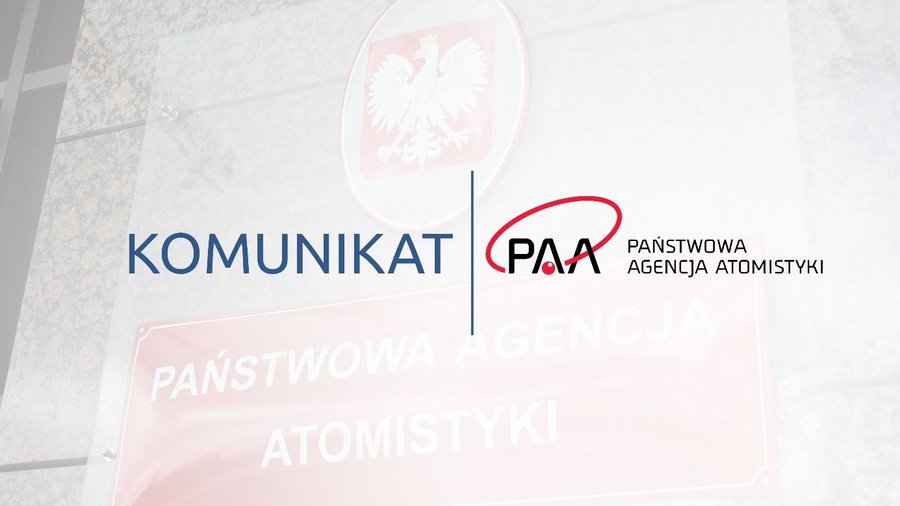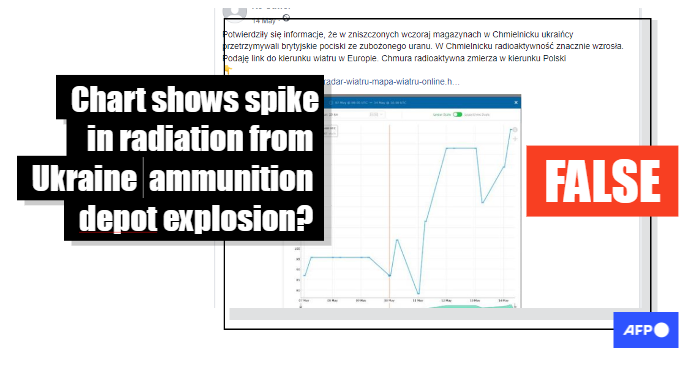The charts are real: one shows data on the metallic element bismuth for the Polish city of Lublin, while the other – taken from the European Commission Radioactivity Environmental Monitoring data bank — shows radioactivity levels for Khmelnytskyi. However, the cause of the higher radiation levels is in fact rain, experts told AFP. Polish, Slovak and Ukrainian authorities — as well as the International Atomic Energy Agency — all said that Europe’s radiation levels were “normal”.
On May 13, 2023, Ukrainian authorities announced that Russia had launched air strikes against Khmelnytskyi. That same day, social media users began posting (here, here, here) videos showing a huge explosion. Some of them called it “practically an atomic mushroom cloud” and claimed it was linked to the destruction of a Ukrainian ammunition depot in Khmelnitskyi.
Several Polish social media users claimed that winds from eastern Ukraine were moving the “cloud” towards Poland. Some of the posts came with a chart. “Reports of destroyed Ukrainian warehouses in Khmelnytskyi, where British depleted uranium shells were stored, have been confirmed. Radioactivity has gone up significantly in Khmelnytskyi. Here is a link where you can check European wind directions to see if radioactive fallout will reach Poland,” read Facebook posts (here and here) published on May 15, 2023, two days after the attack.

Screenshot taken on Facebook on May 23, 2023
The same claim and chart also appeared on Telegram and Twitter.
A Twitter account whose false claims had already previously been verified by AFP also posted a different chart showing bismuth radiation levels. There was a visible spike on May 15. “Radioactivity in the air in Lublin was 300 times higher than normal on the day the Ukrainian radioactive cloud passed through,” claimed the misleading tweet. The same chart with the misleading claim was published on Telegram, where it was viewed more than 1,000 times. The chart also appeared in German, Slovak and Bulgarian, with captions claiming that “the radiation threat came from the Khmelnytskyi region”.

Screenshot taken on Twitter on May 23, 2023
What happened in Khmelnytskyi?
Russia launched a drone attack on Khmelnytskyi Oblast in the early morning of May 13, according to Khmelnytskyi mayor Oleksandr Semchyshyn (here, here, here) and the deputy head of the region’s military administration, Serhiy Tyurin (here, here and here).
Semchyshyn said at the time that the drones struck “critical infrastructure facilities in the region” and injured 21 people. Ukrainian media (here, here) and Polish media also reported on the attack. Some Ukrainian news outlets (here, here) wrote that a power station had sustained damage. The state news agency Ukrinform reported that four drones struck Khmelnytskyi.
The Russian ministry of defence announced on May 14, 2023 that “one AFU ammunition depot ha(d) been destroyed close to Khmelnytskyi”. According to the Russian news agency TASS, Russian Security Council secretary Nikolay Patrushev (archived link) said that the destruction of depleted uranium munitions supplied by the West to Ukraine had created a radioactive cloud that was drifting towards Europe. “An increase in radiation levels has already been registered in Poland,” he warned, quoted by the agency.
Britain did in fact announce in March 2023 that along with its Challenger 2 tanks, it would also send armour-piercing shells containing depleted uranium to Ukraine, as reported by Euronews and the BBC. Delivery was completed in April.
However, AFP could not verify whether that type of ammunition was indeed stored at the Khmelnytskyi facilities struck on May 13.
Depleted uranium is a by-product of the enrichment process needed to transform naturally occurring uranium into fuel used for generating power or weapons. According to the IAEA, it is “considerably less radioactive than natural uranium”. “The chemical toxicity of depleted uranium is considered a more significant issue than the possible impacts of its radioactivity,” according to a 2022 UN Environment Programme (UNEP) report, which added that depleted uranium was an environmental concern in Ukraine.
Chart shows result of rainfall
AFP was able to identify the source of both charts. Doing so was easy in the case of posts where we could see the name of the Polish university UMCS on the chart. On the university website, it is possible to select the same timeframe (May 10-16, 2023) and locate the chart in their archives (see comparison below).

Comparison of the chart from the misleading post on Twitter (left) and the chart from the UMCS radioactivity monitoring project
The university, which is located in the eastern city of Lublin, has been measuring radioactivity in the air there to educate residents and show the correlation between natural radiation and the environment. Just like monitoring bodies — such as the Polish atomic energy agency PAA, or the European Remap — it measures global radioactive contamination (the radiation dose rate) by looking at two main isotopes in particular (synthetic radioisotopes Caesium Cs-137 and Iodine I-131) and also measures the levels of other characteristic isotopes, including Bismuth (Bi-214) – the one featured in the chart from the misleading posts.
We asked the university about the charts. “Yes, this is one of our charts,” said Radoslaw Zaleski, who is in charge of the monitoring project. “It shows bismuth data that we measured at UMCS,” he told AFP on May 23.
He said that unlike Cs-137, which does not exist naturally but is produced by nuclear fission, the isotope Bi-214 is formed by the decay of radon gas rising naturally from the ground. It is intercepted by falling water droplets and when it rains, bismuth falls to the ground. Simply put, the more it rains, the more bismuth will be detected and the curve on the chart will go up, only to go down on a sunny day.
“Such increases occur practically every time it rains and are not dangerous at all for humans,” Zaleski said. “What should put us on alert is the presence of two other isotopes (Iodine and Caesium) on the main chart”. “There, the red line shows an alarming level. In May, it was far below the red line (see online) as there was no radioactive contamination caused by either an incident at a nuclear power plant or nuclear weapons,” he said. In the table below the chart, we can read that Iodine I-131 and Caesium Cs-137 were “not detected”.
“People are afraid of radiation but in reality we are all immersed in it on a daily basis. We are exposed to it all the time. It comes from the Earth’s crust and from solar radiation,” he added. “The word ‘uranium’ scares people. It is important to know that depleted uranium has very low radioactivity and, unlike enriched uranium, cannot be used in nuclear weapons,” he said.
“Such small fluctuations do not impact our health, and even if they did, they are virtually unavoidable,” he said.
The fluctuations in radiation occurred on days when there was rainfall, as shown in the below comparison between the amount of precipitation and radiation intensity (recorded by the UMCS) over the course of a month.

A comparison of the amount of precipitation (upper chart) and radiation intensity for the previous month as recorded by UMCS. Screenshot by AFP on May 24, 2023
In the chart below, we can see many Bi-214 spikes over the course of the year, including in January, February and April. They all correspond to meteorological phenomena. Some were even higher than the one observed after May 13.

Screenshot of UMCS chart taken on May 24, 2023
Indicators for Khmelnytskyi ‘do not exceed’ the norm
By searching the websites of institutions that monitor radioactivity, we located the second chart used in some of the misleading posts. We found it among the radiological maps of the European Commission Radioactivity Environmental Monitoring data bank (REMdb). The map features the blue colour typical of European institution websites. The data bank was created in the aftermath of the 1986 Chernobyl nuclear disaster to “store the radioactivity monitoring data gathered through the national environmental monitoring programmes of the member states”.
We searched for Khmelnytskyi on the radiation map, selected the same dates as in the posts (May 7-14) and obtained the same chart (below).

Comparison of the chart from the misleading post on Facebook (left) and the chart from the EU radioactivity map for Khmelnytsky
We asked the EC REMdb about the chart. In a May 28 email, its representative Juan Carlos de la Rosa Blul confirmed to AFP that the map came from REMdb. He added that specific questions about the data should be directed to the institution that provided the data for station UA33429 in Khmelnitsky, namely the Ukrainian inspectorate.
Contacted by AFP, a spokesman for the State Nuclear Regulatory Inspectorate of Ukraine wrote to AFP on May 26 that “during the period from May 11 to 18, no increases in the permissible radiation background standards were recorded in Khmelnytsky region. The daily fluctuations of gamma radiation were and are currently within the permissible limits, as has been the case for many years of observation. Due to the distribution of fake information in the European media, we provided up-to-date information on the radiation background in Ukraine to our international partners,” including the IAEA and European regulators. He also mentioned a map of the radiation background in Ukraine that is constantly updated.
Researchers from Khmelnytskyi National University went to the site after the May 13 air strike. They denied that radioactivity had increased in the city and the surrounding areas. “After information spread on social media that the increased radiation in Khmelnytskyi was a consequence of the attack on May 13, scientists from Khmelnytskyi National University measured the radiation background (gamma radiation doses) in the city of Khmelnytsky on May 15-16,” reads an article (archived link) on the Ukrainian education ministry’s website.
“The obtained values are 0.12-0.15 μSv/h and correspond to long-term indicators for the territory of Khmelnytskyi and do not exceed the norm (0.3 μSv/h). Based on the measurement results, it can be stated that there is no reason to be concerned about an increase in the radiation background in Khmelnytskyi,” the article concludes. The levels (120 to 150 nSv/h) are almost the same as those on the chart from the misleading posts, which shows 150 nSv/h from May 12.
AFP also asked Slovak officials about the chart. Magdalena Vicanova, head of the Slovak public health authority’s radiation protection department, confirmed on May 23 that the levels observed occur naturally and “are not a threat to human health”.

Screenshot taken on Remap on May 26
We checked the data for the days between May 18 and 25. The radiation level was back down to 70 nSv/h on May 18 (below).

Screenshot taken on Remap on May 26
We know that the attack took place early in the morning on May 13. The first post on Telegram by local authorities was at 4 am local time that day. But the EU chart shows an increase of radiation starting May 12 – so before the attack. It is incomprehensible for the effects to have preceded the attack itself, according to Zaleski.
The European Commission representative also pointed out that the increase occurred prior to the incident.
‘Normal’ radiation levels
AFP asked the International Atomic Energy Agency in Vienna about the alleged radioactive cloud.
“The International Atomic Energy Agency (IAEA) has been informed by its counterparts in Ukraine and Poland that the radiation levels in both countries are normal. The slight increases measured are linked to naturally occurring fluctuations in radiation levels, present no risk to public health or the environment and are routinely observed,” Frederik Dahl, an IAEA spokesman, told AFP on May 23.
On May 17, the Polish atomic energy agency PAA denied the claims of a possible radioactive threat in Poland. It called the reports “false” and reassured residents that the “radiation situation in the country is normal”.

The PAA explained that the UMCS charts “show elevated values of bismuth-214. This is also an effect of precipitation. Bismuth-214 (…) naturally occurs on the earth’s surface and in the atmosphere in the form of aerosols. When it rains, aerosols containing Bi-214 are lifted from the earth’s surface and also leached from the atmosphere”.
The Polish Institute of Meteorology and Water Management IMGW, which also monitors radioactivity levels, said that there had been no health hazard. “We checked our data, though we have far fewer stations than the PAA, and in our case, we did not record anything dangerous,” spokesman Grzegorz Walijewski told AFP on May 23.
In Slovakia, where the false claims was also shared on social media, the Public Health Office published a press release on May 18 (link archived here) describing the claims as “misinformation” and stressing that “values in Slovakia and Poland are normal”.
“A lot of misinformation appeared in Slovakia about increased radiation in connection with the events in the area of the Ukrainian city of Khmelnytskyi,” Branislav Chvila, director of the Hydrometeorological Institute SHMU, said that same day. “We consider the reports to be a hoax,” he added.
The French institute for radiation protection and nuclear safety IRSN wrote on May 30 that because uranium cannot travel very far, it “appears unlikely” that a radioactive plume had travelled outside Ukraine.
“Analyses carried out in Europe did not reveal any increase in the concentration of uranium in the air,” the institute added, referring to the Ring of Five, an informal network that brings together 47 organisations — university laboratories, public bodies and authorities — representing 27 countries in Europe, including Ukraine.
Maja Czarnecka
Translated by Anna Maria Jakubek

- Home
- About AFP
- How we work
- Editorial & Ethical standards
- Fact-Checking Stylebook
- Meet the team
- Training
- Subscribe
- Contact
- Corrections
Copyright © AFP 2017-2023. All rights reserved. Users can access and consult this website and use the share features available for personal, private, and non-commercial purposes. Any other use, in particular any reproduction, communication to the public or distribution of the content of this website, in whole or in part, for any other purpose and/or by any other means, without a specific licence agreement signed with AFP, is strictly prohibited. The subject matter depicted or included via links within the Fact Checking content is provided to the extent necessary for correct understanding of the verification of the information concerned. AFP has not obtained any rights from the authors or copyright owners of this third party content and shall incur no liability in this regard. AFP and its logo are registered trademarks.
